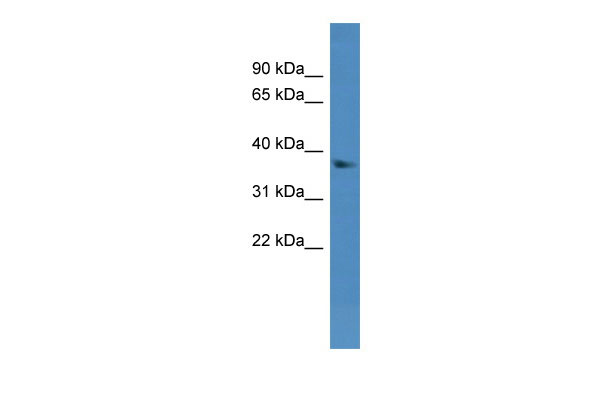Dhrs7 antibody - N-terminal region
Rabbit Polyclonal Antibody
- 产品详情
- 实验流程
Application
| WB |
|---|---|
| Primary Accession | Q9CXR1 |
| Other Accession | NM_025522, NP_079798 |
| Reactivity | Human, Mouse, Rat, Rabbit, Pig, Dog, Guinea Pig, Horse, Bovine |
| Predicted | Human, Mouse, Rat, Pig, Dog, Bovine |
| Host | Rabbit |
| Clonality | Polyclonal |
| Calculated MW | 38167 Da |
| Gene ID | 66375 |
|---|---|
| Alias Symbol | 2310016E22Rik, 5730564L20Rik, AW061210, Retdsr4, Retsdr4 |
| Other Names | Dehydrogenase/reductase SDR family member 7, 1.1.-.-, Retinal short-chain dehydrogenase/reductase 4, retSDR4, Dhrs7, Retsdr4 |
| Format | Liquid. Purified antibody supplied in 1x PBS buffer with 0.09% (w/v) sodium azide and 2% sucrose. |
| Reconstitution & Storage | Add 50 ul of distilled water. Final anti-Dhrs7 antibody concentration is 1 mg/ml in PBS buffer with 2% sucrose. For longer periods of storage, store at 20°C. Avoid repeat freeze-thaw cycles. |
| Precautions | Dhrs7 antibody - N-terminal region is for research use only and not for use in diagnostic or therapeutic procedures. |
| Name | Dhrs7 {ECO:0000312|MGI:MGI:1913625} |
|---|---|
| Synonyms | Retsdr4 |
| Function | NADPH-dependent oxidoreductase which catalyzes the reduction of a variety of compounds bearing carbonyl groups including steroids, retinoids and xenobiotics. Catalyzes the reduction/inactivation of 5alpha-dihydrotestosterone to 3alpha-androstanediol, with a possible role in the modulation of androgen receptor function. Involved in the reduction of all-trans-retinal to all-trans-retinol. Converts cortisone to 20beta-dihydrocortisone in vitro, although the physiological relevance of this activity is questionable. Reduces exogenous compounds such as quinones (1,2-naphtoquinone, 9,10-phenantrenequinone and benzoquinone) and other xenobiotics (alpha-diketones) in vitro, suggesting a role in the biotransformation of xenobiotics with carbonyl group. A dehydrogenase activity has not been detected so far. May play a role as tumor suppressor. |
| Cellular Location | Endoplasmic reticulum membrane {ECO:0000250|UniProtKB:Q9Y394}. Note=Bound to the endoplasmic reticulum membrane, possibly through a N-terminus anchor. The main bulk of the polypeptide chain was first reported to be facing toward the lumen of the endoplasmic reticulum. However, it was later shown to be facing the cytosol. {ECO:0000250|UniProtKB:Q9Y394} |
Research Areas
For Research Use Only. Not For Use In Diagnostic Procedures.
Application Protocols
Provided below are standard protocols that you may find useful for product applications.
终于等到您。ABCEPTA(百远生物)抗体产品。
点击下方“我要评价 ”按钮提交您的反馈信息,您的反馈和评价是我们最宝贵的财富之一,
我们将在1-3个工作日内处理您的反馈信息。
如有疑问,联系:0512-88856768 tech-china@abcepta.com.























 癌症的基本特征包括细胞增殖、血管生成、迁移、凋亡逃避机制和细胞永生等。找到癌症发生过程中这些通路的关键标记物和对应的抗体用于检测至关重要。
癌症的基本特征包括细胞增殖、血管生成、迁移、凋亡逃避机制和细胞永生等。找到癌症发生过程中这些通路的关键标记物和对应的抗体用于检测至关重要。 为您推荐一个泛素化位点预测神器——泛素化分析工具,可以为您的蛋白的泛素化位点作出预测和评分。
为您推荐一个泛素化位点预测神器——泛素化分析工具,可以为您的蛋白的泛素化位点作出预测和评分。 细胞自噬受体图形绘图工具为你的蛋白的细胞受体结合位点作出预测和评分,识别结合到自噬通路中的蛋白是非常重要的,便于让我们理解自噬在正常生理、病理过程中的作用,如发育、细胞分化、神经退化性疾病、压力条件下、感染和癌症。
细胞自噬受体图形绘图工具为你的蛋白的细胞受体结合位点作出预测和评分,识别结合到自噬通路中的蛋白是非常重要的,便于让我们理解自噬在正常生理、病理过程中的作用,如发育、细胞分化、神经退化性疾病、压力条件下、感染和癌症。






